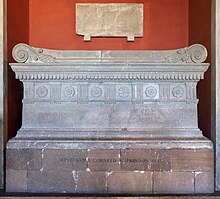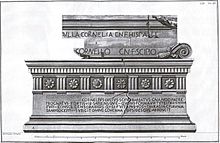46:
179:
before the new text was cut, why was more trouble not taken to smooth and prepare the stone? Moreover, why does our text start at a distance of a third of a line from the margin? It would have been easy for the mason to produce a better surface so that he could have started at the margin. The whole execution of the inscription itself is very fine and clearly not the work of an amateur. The overall impression is that no expense was spared in the layout of a large tomb and the manufacture of a magnificent sarcophagus for its first occupant.
190:
for their continued search for earlier ancestors. This was done partly by invention and partly by substitution of the cognomen Scipio for earlier ones of branches that later died out... It is possible, therefore, that
Barbatus'......became an obstacle to later family members who were eager to find earlier ancestors and other founders, who could compete with the claims of rival families. Such a reconstruction, while it can not be proved, is at least plausible and in accord with the other available evidence."
71:
178:
The most compelling arguments that suggest the removal of part of the same verse text we now have relate to the shape and character of the erasure itself. In effect, a fine sarcophagus, which was inscribed with a long and carefully executed text, is marred by a rough erasure. If the erasure was made
169:
There is a rough-hewn area above the epitaph, where it appears that some text has been erased. This has traditionally been interpreted as evidence of an earlier, shorter epitaph, which was replaced by the surviving text at a later date. More recently, however, a detailed analysis of the epitaph has
189:
Since the tomb was closed in the late
Republic, the erasure must date to the middle Republic, and since the tombs were private, the erasure must have been done at the request of an authoritative male family member. In her review of the epitaph, Harriet Flower notes that "The Scipios are also known
182:
If a short, earlier text had indeed been inscribed, there would have been no reason to write it in small letters at the very top of the ample space available on the front of the sarcophagus. It would surely have been placed more in the middle and in larger letters... Barbatus’ erasure suggests that
61:
VI 1285) on the front of the only intact sarcophagus (some of the decorative detail has been restored). The letters were originally painted red. A Doric-style decorative panel is above the inscription featuring roses alternating with column-like triglyphs. The top of the sarcophagus is modeled as a
183:
the letters were the same size and the lines the same length as the extant text. The erasure comprises exactly the length of two of the
Saturnian verses below. All these considerations strongly suggest that part of this same text was erased.
198:
The bones of
Barbatus, along with a gold signet ring taken from his finger bone, were removed from the sepulcher in the excavations of 1780 and initially went to the Vatican along with everything else of value in the tomb.
45:
185:
The question remains as to what was erased by a later family member... Whatever was rubbed out must have been controversial or unsatisfactory from the family’s point of view
207:. The gardens were later destroyed, and the fate of the bones is unknown. The gold ring was given by Pius IV to a French scholar, Louis Dutens, who later sold it to the
149:
Cornelius Lucius Scipio
Barbatus, sprung from Gnaeus his father, a man strong and wise, whose appearance was most in keeping with his virtue, who was
423:
223:
confirmed in 2015 that it was still in the collection, which makes it the only ancient Roman ring which can be traced to an original owner.
463:
203:
gave the bones to a
Venetian Senator, Angelo Quirini, who re-interred them in an elaborate sepulcher in the gardens of his villa near
208:
282:
174:
the original inscription, but that the first part of the epitaph has been deleted. A summary of this analysis states:
458:
374:
324:
22:
349:
242:
58:
54:
302:
Altlateinische
Inschriften. Sprachliche und epigraphische Untersuchungen zu den Dokumenten bis etwa 150 v. Chr
402:
220:
417:
212:
74:
263:, Metropolitan Museum of Art Guide edited by Philippe De Montebello, Kathleen Howard, p. 186.
154:
35:
8:
344:(illustrated ed.). Chapel Hill: University of North Carolina Press. pp. 55–57.
31:
85:
370:
345:
320:
238:
260:
216:
70:
39:
396:
452:
211:. By the late 19th century it had found its way into the collection of the
200:
105:
which has been stated in modern upper- and lower-case script as the verse:
342:
The art of forgetting: disgrace & oblivion in Roman political culture
138:
fuit, Consul, Censor, Aedilis, qui fuit apud vos; Taurasiam
Cisaunam,
82:
162:
158:
150:
135:
prognatus, fortis vir sapiensque, cuius forma virtuti parissima
98:
FVIT—CONSOL CENSOR·AIDILIS·QVEI·FVIT·APVD·VOS—TAVRASIA·CISAVNA
95:
PROGNATVS·FORTIS·VIR·SAPIENSQVE—QVOIVS·FORMA·VIRTVTEI·PARISVMA
204:
27:
369:. Oxford, UK: Oxford University Press. pp. 176–177.
319:. Oxford, UK: Oxford University Press. pp. 173–176.
141:
Samnio cepit, subigit omnem
Lucaniam, obsidesque abducit.
109:
Cornelius Lucius Scipio
Barbatus Gnaivod Patre Prognatus
367:
Ancestor masks and aristocratic power in Roman culture
317:
Ancestor masks and aristocratic power in Roman culture
101:
SAMNIO·CEPIT—SVBIGIT·OMNE·LOVCANA·OPSIDESQVE·ABDOVCIT
34:. It is now found in the Vestibolo Quadrato of the
81:His sarcophagus preserves his epitaph, written in
165:– he subdued all of Lucania and led off hostages.
450:
436:
237:(illustrated ed.). Kessinger Publishing.
92:CORNELIVS·LVCIVS·SCIPIO·BARBATVS·GNAIVOD·PATRE
394:
132:Cornelius Lucius Scipio Barbatus, Gnaeo patre
161:among you – He captured Taurasia Cisauna in
128:and also transcribed in classical Latin as:
439:The Ruins & Excavations of Ancient Rome
422:: CS1 maint: numeric names: authors list (
287:An Elementary Manual of Roman Antiquities
124:Subigit Omne Loucana Opsidesque Abdoucit.
65:
118:Consol Censor Aidilis Quei Fuit Apud Vos
69:
44:
398:Mary Beard on SPQR: The History of Rome
390:
388:
386:
299:
451:
364:
339:
314:
281:
304:. Bern: Peter Lang. pp. 301–342.
232:
383:
16:Monument in the Vatican Museum, Rome
266:
115:Quoius Forma Virtutei Parisuma Fuit
30:burial coffin, once located in the
13:
235:Vatican: Its History Its Treasures
170:suggested that the surviving text
14:
475:
464:Collection of the Vatican Museums
26:, consul in 298 B.C., is a solid
441:. Houghton Mifflin. p. 322.
53:The name is incised on the lid (
23:Lucius Cornelius Scipio Barbatus
405:from the original on 2021-12-21
430:
358:
333:
308:
293:
275:
254:
49:Sarcophagus of Scipio Barbatus
1:
226:
121:Taurasia Cisauna Samnio Cepit
395:92nd Street Y (2015-11-10).
7:
365:Flower, Harriet I. (1996).
340:Flower, Harriet I. (2006).
315:Flower, Harriet I. (1996).
193:
57:VI 1284) and the epitaph (
10:
480:
437:Rodolfo Lanciani (1897).
459:Ancient Roman sarcophagi
300:Wachter, Rudolf (1987).
77:'s engraving of epitaph.
233:Ricci, Corrado (2003).
213:Dukes of Northumberland
187:
78:
66:Epitaph on Sarcophagus
50:
176:
112:Fortis Vir Sapiensque
73:
48:
36:Pio-Clementine Museum
272:Ricci (2003) p. 395.
32:Tomb of the Scipios
145:A translation is:
79:
51:
219:. The classicist
471:
443:
442:
434:
428:
427:
421:
413:
411:
410:
392:
381:
380:
362:
356:
355:
337:
331:
330:
312:
306:
305:
297:
291:
290:
279:
273:
270:
264:
258:
248:
209:Earl of Beverley
479:
478:
474:
473:
472:
470:
469:
468:
449:
448:
447:
446:
435:
431:
415:
414:
408:
406:
401:. YouTube.com.
393:
384:
377:
363:
359:
352:
338:
334:
327:
313:
309:
298:
294:
283:Ramsay, William
280:
276:
271:
267:
259:
255:
245:
229:
196:
184:
181:
180:
68:
21:sarcophagus of
17:
12:
11:
5:
477:
467:
466:
461:
445:
444:
429:
382:
375:
357:
350:
332:
325:
307:
292:
289:. p. 247.
274:
265:
252:
251:
250:
249:
243:
228:
225:
217:Alnwick Castle
195:
192:
167:
166:
143:
142:
139:
136:
133:
126:
125:
122:
119:
116:
113:
110:
103:
102:
99:
96:
93:
67:
64:
40:Vatican Museum
15:
9:
6:
4:
3:
2:
476:
465:
462:
460:
457:
456:
454:
440:
433:
425:
419:
418:cite AV media
404:
400:
399:
391:
389:
387:
378:
376:0-19-924024-8
372:
368:
361:
353:
347:
343:
336:
328:
326:0-19-924024-8
322:
318:
311:
303:
296:
288:
284:
278:
269:
262:
257:
253:
246:
240:
236:
231:
230:
224:
222:
218:
214:
210:
206:
202:
191:
186:
175:
173:
164:
160:
156:
152:
148:
147:
146:
140:
137:
134:
131:
130:
129:
123:
120:
117:
114:
111:
108:
107:
106:
100:
97:
94:
91:
90:
89:
87:
84:
76:
72:
63:
60:
56:
47:
43:
41:
37:
33:
29:
25:
24:
438:
432:
407:. Retrieved
397:
366:
360:
341:
335:
316:
310:
301:
295:
286:
277:
268:
256:
234:
201:Pope Pius VI
197:
188:
177:
171:
168:
144:
127:
104:
80:
52:
20:
18:
261:The Vatican
453:Categories
409:2020-04-24
351:0807830631
244:0766139417
227:References
221:Mary Beard
86:Saturnian
83:Old Latin
62:cushion.
42:complex.
403:Archived
285:(1859).
194:Contents
75:Piranesi
163:Samnium
88:meter:
38:in the
373:
348:
323:
241:
159:aedile
157:, and
155:censor
151:consul
205:Padua
424:link
371:ISBN
346:ISBN
321:ISBN
239:ISBN
28:tuff
19:The
215:at
59:CIL
55:CIL
455::
420:}}
416:{{
385:^
172:is
153:,
426:)
412:.
379:.
354:.
329:.
247:.
Text is available under the Creative Commons Attribution-ShareAlike License. Additional terms may apply.

